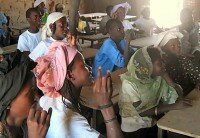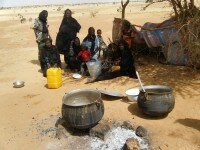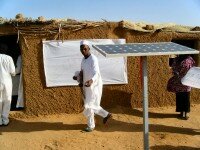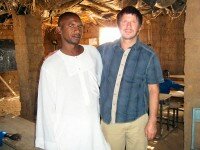Solar power for a Saharan school
Posted in Climate Answers' projects on 02/23/2011 02:04 pm by Just over two years ago, I was invited by a friend to consider whether my school would like to make a link with a school in the Sahara. Romana Cacchioli, who works for human rights organisation, Antislavery International, told me that the African school was in a remote northern region of Niger, that we would have to communicate in French and that there was no Internet or telecommunication links with the school. “So how do we contact them?” I asked. Romana told me that she visited the school fairly regularly and could facilitate the link. I thought about the barriers. On reflection, I felt that such a partnership could be perfect for our school; Gillespie children had recently started to learn French as part of their curriculum development and this would give a purpose to their learning. The idea of having to deliver our messages by hand would be rather special in this fast moving world and help to convey an understanding of the vast distances between the respective schools. So I said, “yes”. Thus, we began a relationship based on mutual respect and interest.
Just over two years ago, I was invited by a friend to consider whether my school would like to make a link with a school in the Sahara. Romana Cacchioli, who works for human rights organisation, Antislavery International, told me that the African school was in a remote northern region of Niger, that we would have to communicate in French and that there was no Internet or telecommunication links with the school. “So how do we contact them?” I asked. Romana told me that she visited the school fairly regularly and could facilitate the link. I thought about the barriers. On reflection, I felt that such a partnership could be perfect for our school; Gillespie children had recently started to learn French as part of their curriculum development and this would give a purpose to their learning. The idea of having to deliver our messages by hand would be rather special in this fast moving world and help to convey an understanding of the vast distances between the respective schools. So I said, “yes”. Thus, we began a relationship based on mutual respect and interest.
Inazgar School was set up for children of former enslaved Tuareg people, in the northern desert region of Niger and is jointly funded by Comic Relief and the Niger government. It is managed by Timidria, a Niger Human rights organisation with support from Antislavery International. The school has two classrooms, one for infants and the other for juniors. Resources are limited, but the children could not be more enthusiastic about their learning.
Contact was first made when the Inazgar children received a beautiful book made by Gillespie children. The book included articles and photographs of some of our children and our school building. Romana travelled to the school with the book and reported that the children loved it. They were fascinated by pictures of our three-storey, Victorian school covered in snow and by the diversity of children represented at our school, including some who were dressed in similar clothes and had similar skin colour to themselves. The book became an instant favourite.
Some months later Romana returned to visit Gillespie school with photos and videos she had taken of the Inazgar children, drawings, writing and gifts of local art and traditional crafts made by children and adults in the village. Our children were so excited.
We discussed how we could start to make some curriculum links between the two schools. Looking at the photos, it was obvious that in Inazgar the best possible use had to be made of scarce resources, including water. Some of the buildings had maize sacks sewn into the walls to help shield from the blazing heat. This was an area where we could learn much from our partner school. It would enable our children to consider issues about sustainability, which would link in with a new Green team we were introducing to Gillespie School.
One of our parents, Stephen Tindale, has been advising and supporting the school in our efforts to become greener, and made a generous donation to Gillespie school in 2009 so that we could double glaze some of our school windows. In a chance conversation about Niger with Stephen, I explained that the school had very basic facilities and no electricity. Stephen was very keen to use the balance of his donation to Gillespie to enable Inazgar School to have a solar photovoltaic panel, which could provide electricity for lighting. In due course, this was facilitated. A simple single panel on a stand provides light in the school house after the sun has set. This innovation has created much excitement in Inazgar and now means that the school house is often a meeting place for the local villagers and community in the evenings.
During 2010, Gillespie School and Inazgar School received a Global Partnership reciprocal visits grant to enable the respective heads to visit each other’s schools to build on our partnership and foster further cultural and curriculum links. I visited Inazgar School in October 2010. I found Niger to be an intense and vibrant country, with peoples’ struggle against poverty and the climate serving to strengthen cultural and community traditions.
After hurtling almost 1,000 miles across the desert in an ancient four-wheel drive , I arrived at Inazgar and was welcomed by the villagers in traditional style, sharing food from huge circular plates while sheltering from the intense heat beneath leather-sewn low tents. The children in the school were brilliant, as was their head teacher, Adam, who welcomed me with grace. His dedication to his school children was inspiring. I sang songs with the children and got them to help me tell the story of ‘Unanana and the enormous one tusked elephant’. Of course, I found that children’s love of story is universal.
 Adam talked to me about the challenges and successes of his work at the school. He showed me the solar panel and the lights that lit up this community in the dark, and explained that the school house could now be used in the evening. We also discussed the constant problem of providing enough fresh water for the children to drink during school hours. The local well had not been dug deeply enough and was almost dry. Each morning, before school starts, villagers travel three to four miles on a donkey to bring back water to the school from a seasonal lake, which is rapidly drying up. I was told that a new well would need to be dug, at least 80m deep. This is an engineering job that will cost thousands of pounds, funding not available to the schools project. Yet, just like the solar panelling, a relatively small sum of money could safeguard the village of Inazgar and its school of 50 or so enthusiastic children by providing a secure and clean supply of water for all.
Adam talked to me about the challenges and successes of his work at the school. He showed me the solar panel and the lights that lit up this community in the dark, and explained that the school house could now be used in the evening. We also discussed the constant problem of providing enough fresh water for the children to drink during school hours. The local well had not been dug deeply enough and was almost dry. Each morning, before school starts, villagers travel three to four miles on a donkey to bring back water to the school from a seasonal lake, which is rapidly drying up. I was told that a new well would need to be dug, at least 80m deep. This is an engineering job that will cost thousands of pounds, funding not available to the schools project. Yet, just like the solar panelling, a relatively small sum of money could safeguard the village of Inazgar and its school of 50 or so enthusiastic children by providing a secure and clean supply of water for all.
On my return to England, I shared stories of my trip with Gillespie children. The school Council expressed a wish to raise money on Red Nose Day this year specifically to go towards building a new well at Inazgar. We have thus far built up our school links based upon learning about and from each other. It is a relationship that has brought riches to Gillespie School. However, I am delighted that, in our own small way, we are going to try and help our partner school to survive. At Gillespie, we will be working harder than usual in March 2011 to raise as much comic relief money as we can to help Inazgar School get what is surely the right of every person on this planet, a daily supply of fresh clean water .
 Mark Owen, head teacher, Gillespie school
Mark Owen, head teacher, Gillespie school


